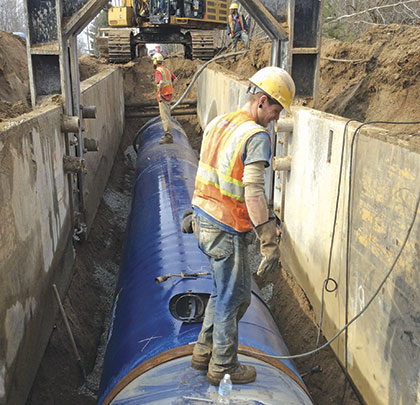In the wake of the Flint water crisis, a huge spotlight has been turned on infrastructure in America, and specifically, the country’s miles-long network of aging underground water pipes. While there are new short-term efforts to bring fresh water into Flint, plans have been in the works for several years that should provide a long-term solution.
In 2013, ground was broken on the Karegnondi Water Authority (KWA) pipeline, a multi-year water intake pipeline project that will bring raw water 75 miles from Lake Huron west along the I-69 corridor through Michigan’s Sanilac, Lapeer, St. Clair, and Genessee counties; including servicing the City of Flint.
The $285 million project—years in the making—has many parts: a new state-of-the-art water intake facility which bores 6,000 feet into Lake Huron, two water treatment plants, plus three new pump stations. But even with all the peripheries, the KWA pipeline project is just that—a pipeline.
In 2013, Zito Construction, headquartered in Grand Blanc, Michigan, was contracted by the KWA to install 36 inch diameter steel Class 150 pipe along an approximately 14-mile stretch of the main line from Genessee to Lapeer County. That was completed in 2014. The Authority again awarded Zito an approximately $18 million contract to install 68,500 linear feet of much larger 60 inch diameter spiral steel transmission pipe across parts of Lapeer County.
Zito began the second portion of the pipeline in April 2015. With such a distance to cover, Zito is installing extremely long 50 foot joints of pipe. The more than 1,600 jumbo pieces of pipe are being placed in an open cut trench ranging from 5 to 25 feet deep. Because the trench is deeper than 5 feet, a trench protection system is required. And therein lies the biggest challenge for the veteran underground utility contractor.
THE CHALLENGE
There are only so many ways to shore a trench and still be able to install pipe 50 feet long, with soil conditions typically being the primary factor driving the choice of the trench protection system. “Ground conditions along the pipeline can best be described as ‘sandy to swampy,’” says Jeremy Drielick, senior engineering technician with Rowe Professional Services Company, the engineering firm responsible for Zito’s second portion of the KWA pipeline. “And that about covers it,” Drielick adds.
“Because of the ground conditions, we knew we couldn’t slope the trench and not take out the whole road in some places,” says John Zito, president of his namesake company. “If we could have sloped it we might have moved along faster, but sloping or some kind of shoring just wasn’t economical,” he says. “We knew we were going to need a (trench) box. A very big trench box.”
THE SOLUTION
Even with the trench protection system decided, Zito still faced many challenges. The question still remained, how do you install 50 foot sticks of pipe in a trench box? For help, Zito turned to their go-to source for underground safety-related equipment—Mid-Michigan based Efficiency Production.
“It’s actually not as hard as you might think,” assures Mike West, Efficiency Production’s vice president of engineering. “We’ve built several custom trench shields in the past exactly for the same purpose, installing joints of pipe 50 feet or longer,” he says. “The key is designing a box with enough pipe clearance so the contractor can angle the pipe into the box and under spreader arches,” West explains.
CUSTOM TRENCH BOXES
Efficiency’s solution is accomplished by using two trench shields with custom high-clearance arches instead of spreader pipe on the abutted ends of the boxes. “The shields we built for Zito, however, are different in that the lead box is so much longer than the trailing box,” says West. “What you end up with is a lot of space to get the pipe into the front box and under the arches, and then just enough space in the second box to shield the connection work,” he says.
Zito’s custom trench shields are a combination of a HDHT12-842 steel trench shield with 12 inch thick sidewalls, 8 feet high, and 42 feet long; adjoined with an XLD-816 steel trench shield with 4 inch thick sidewalls, 8 feet high and 16 feet long. Each box has a hi-clearance arch on one end that are abutted to each other, and the boxes are secured together with shackles for easy pulling through the trench. The opposite end of each trench shield has 9 foot spreaders to match the overall width of the arches.
The result is a trench shield almost 60 feet long with more than 11 feet of pipe clearance; plenty of room for Zito’s excavator operator and crew to angle the spigot end of the pipe into the connected boxes and up to the bell end of the installed pipe. The pipe is then tack-welded and heat shrink wrapped on the outside before a welding crew from Utah-based subcontractor National Welding traverses the inside of the pipeline to permanently weld all the joints from the inside.
“The box is working well,” says Zito. “Our record is 11 sticks of pipe in one day,” he adds. “Yeah, the box is working very well.” Zito is anticipating being finished installing this section of the pipeline by June 2016.
The new KWA pipeline will supply treated and untreated water to the municipalities of the region, industrial customers, agribusinesses, rural agriculture developments, and residential commercial light and heavy manufacturers. The boundaries of the water supply will encompass over 2,400 square miles and over a half million people. ■
About the Author: James McRay is the director of marketing and media for Efficiency Production, Inc., “America’s Trench Box Builder™,” providing the widest selection of standard and custom trench shielding and shoring systems. All products are P.E. certified to meet OSHA standards. For more information, visit www.efficiencyproduction.com. For more information about Zito Construction, visit www.zitoconstruction.com.
_________________________________________________________________________
Modern Contractor Solutions – June 2016
Did you enjoy this article?
Subscribe to the FREE Digital Edition of Modern Contractor Solutions magazine.

Bringing Fresh Water to Flint


